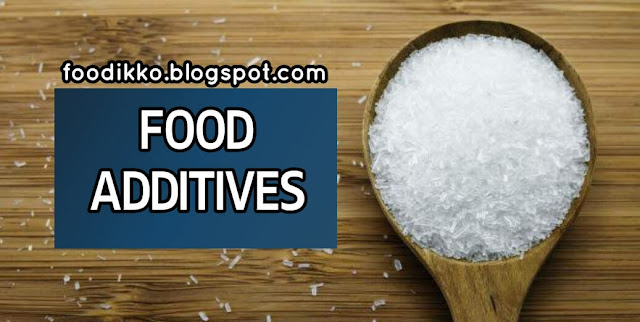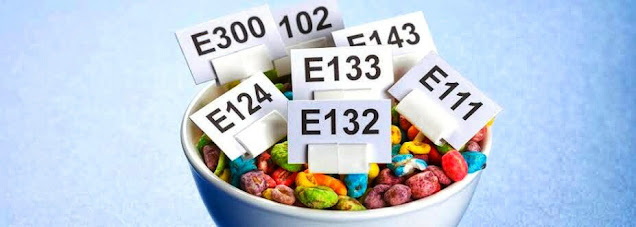FOOD ADDITIVES
this definition of food additives include both intentional and unintentional food additives.
- Unintentional food additives are non added into food to achieve any spacial effect It may accidentally enter into food as a result of agricultural production feeding of animal food processing or packaging
- Intentional food additives are the substance which may added to food for spacial purpose it include preservatives,anti-oxidants,thickening agents,leavening agents,stabilizing agents,flavouring agents, flavouring enhancers,coloring agents,non nutritive dietary sweeteners,nutrient supplements,..
- Examples of food additives: MSG, BHT, BHA, sodium benzoate, SO2, salt, sugar, vinegar, lecithene, PG,..
Classifications of Food Additives
Food Preservatives
Salt
Salt is effective as a preservative because it reduces the water activity of foods.salt act by dehydration and inhibits bacterial growth and prevent the spoilage. Salt also inhibit the growth of micro organisms by drawing water out of inner cells through osmosis.use of salt alone gives a harsh dry salty product that is not palatable. Also salt alone results in a dark, undesirable colored product due to some undesirable effect, due to this reason salt is used in combination with other ingredients.
Sugar
Vinegar
Sulphur dioxide
Benzoic acid and Sodium benzoate
Anti oxidants
Surface active agents
Flavouring enhancers
Maturing agents
Common Food Additives
Sodium Benzoate
Potassium bromate
Sodium nitrite
Controversial Food Additives
Monosodium Glutamate (MSG)
Food Additives and Food Adulteration
What is the difference between additives and adulterants?
An additive, on the other hand, is permissible and in many cases an essential ingredient added to certain foods. Additives improve the general quality of the food or preserve the product in the same condition for a longer duration, or they help counteract undesirable properties. Additives also enhance flavor and appearance besides lending safe keeping to the product and continue to garner more popularity with the rise in demand for packaged foods. Additives range from simple table salt to chemicals and they reduce spoilage from sources like air or bacteria, many additives also absorb radiation.
Pros and Cons of Food Additives
Why Food Additives are Added to Food?
Additives perform a variety of useful functions in foods that consumers often take for granted. Some additives could be eliminated if we were willing to grow our own food, harvest and grind it, spend many hours cooking and canning, or accept increased risks of food spoilage. But most consumers today rely on the many technological, aesthetic and convenient benefits that additives provide.
Following are some reasons why ingredients are added to foods:
- To Maintain or Improve Safety and Freshness: Preservatives slow product spoilage caused by mold, air, bacteria, fungi or yeast. In addition to maintaining the quality of the food, they help control contamination that can cause foodborne illness, including life-threatening botulism. One group of preservatives -- antioxidants -- prevents fats and oils and the foods containing them from becoming rancid or developing an off-flavor. They also prevent cut fresh fruits such as apples from turning brown when exposed to air.
- To Improve or Maintain Nutritional Value: Vitamins and minerals (and fiber) are added to many foods to make up for those lacking in a person's diet or lost in processing, or to enhance the nutritional quality of a food. Such fortification and enrichment has helped reduce malnutrition in the U.S. and worldwide. All products containing added nutrients must be appropriately labeled.
- Improve Taste, Texture and Appearance: Spices, natural and artificial flavors, and sweeteners are added to enhance the taste of food. Food colors maintain or improve appearance. Emulsifiers, stabilizers and thickeners give foods the texture and consistency consumers expect. Leavening agents allow baked goods to rise during baking. Some additives help control the acidity and alkalinity of foods, while other ingredients help maintain the taste and appeal of foods with reduced fat content.
Food Additive Disadvantages
Some food additives can potentially cause harmful side effects. For example, butylated hydroxyanisole, commonly known as BHA, is a preservative used in foods including potato chips, crackers, beer, baked goods and cereal. It has been classified by the U.S. Department of Health and Human Services as a preservative "reasonably anticipated to be a human carcinogen." Sulfites, which are added to baked goods, wine, condiments and snack foods, could cause hives, nausea, diarrhea and shortness of breath in some people.
How Are Additives Approved for Use in Foods?
Today, food and color additives are more strictly studied, regulated and monitored than at any other time in history. FDA has the primary legal responsibility for determining their safe use. To market a new food or color additive (or before using an additive already approved for one use in another manner not yet approved), a manufacturer or other sponsor must first petition FDA for its approval. These petitions must provide evidence that the substance is safe for the ways in which it will be used. As a result of recent legislation, since 1999, indirect additives have been approved via a premarket notification process requiring the same data as was previously required by petition.
Food Additives and FSSAI
Food Safety Standard Authority of India describes food additives and its permitted levels in their official site. You can download a detailed food additives pdf from this site.it include food additives classification, qualitative and quantitative test of food additives. FSSAI has food safety standards and laws to regulate the usage of food additives.
Food Additives QnA
- Are food additives good or bad?
Additives are not necessarily bad. Most foods require them to prevent spoilage and maintain their nutritional value.
- Are food additives safe?
When all is said and done, additives are believed to be safe for most people most of the time. Some, like ascorbic acid, can even enhance our health. This additive, used to provide color in meat and nutrition in beverages, is nothing more than vitamin C, which might reduce the severity of colds.
- Are food additives healthy?
When all is said and done, additives are believed to be safe for most people most of the time. Some, like ascorbic acid, can even enhance our health. This additive, used to provide color in meat and nutrition in beverages, is nothing more than vitamin C, which might reduce the severity of colds.
- Are food additives addictive?
A new study shows that processed foods can be addictive because the added chemicals trigger the same kinds of brain activity seen in substance dependence.
- Are food additives are costly?
Many of these additives were expensive, and only the rich were able to afford them.but some food additives are naturally available.
- Are food additives cause headache?
- Are food additives allergenic?





1 Comments
Wow what a great blog, i really enjoyed reading this, good luck in your work. Anti-Microbial Natural Additives
ReplyDelete